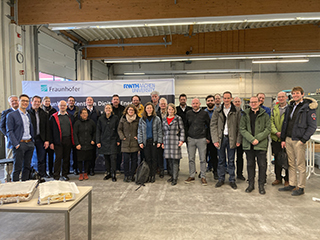Ergonomic assistance systems for grid control centers in critical infrastructures
The secure operation of gas and electricity grids is ensured by reliable technologies and, in particular, by the broad experience of control center personnel. The increasing technological and systemic complexity of energy systems and the increased risk of cyber-attacks lead to a significant increase in relevant process information that needs to be taken into account for safe grid management. The BMBF-funded project "Beautiful"s target is to optimize the working conditions of control center personnel in critical infrastructures.

Control center personnel are responsible for operating gas and electricity grids safely and reliably. Whereas critical network situations were previously often caused by physical impacts on the infrastructure, for example, when lines were damaged by excavation work or falling trees, in the future complex cross-sector dependencies and cyber-attacks will also have to be considered as sources of danger.
Integrating renewable energy sources into the energy system requires the development of new control mechanisms to optimize the energy mix while ensuring the security of supply at all times. Wind and solar energy are fed into the power grid volatilely. The fluctuating feed-in needs to be balanced permanently with the likewise volatile load. Renewable energy through biogas and hydrogen is fed into the gas grid. The sources of supply for natural gas are strongly diversified. Due to the flexible operating conditions, the gas grid can be well adapted to the changing conditions and additionally operated in a grid-serving way for the electricity grid. Gas-fired power plants are suitable for providing peak load. They can be quickly ramped up and down, stabilizing the power grid. The gas grid can also serve as seasonal energy storage by storing surplus energy in the form of hydrogen or methane, even in the long term, and converting it back into electricity when needed. The control center personnel always balance gas quantity, pressure, and quality and can use permissible tolerances for optimization.
For safe cross-sector control, more and more information is being collected in the control centers, which must be incorporated into targeted operation decisions. More and more digital technologies are being used to manage this rapidly growing complexity. This, in turn, increases the risk of cyber-attacks. The causes of critical network conditions are not only becoming more diverse, but the cascade potential is also increasing.
An interdisciplinary consortium is taking up the challenge of developing high-performance assistance systems for the increasingly complex monitoring and control tasks in the project "Beautiful – Belastungsoptimierte Arbeitsgestaltung für Netzleitstellen kritischer Infrastruktur". The assistance systems should support safe decisions in complex situations within the shortest possible time. Transparency and trust in these systems are to be supported via a standardized evaluation of the added value for control center personnel.
For this purpose, the current working conditions of control center personnel of a grid operator are first evaluated. Two control center simulators are developed for the ergonomic assessment of the physio-psychological states of control center personnel under different stress conditions.
A control center simulator will be used in an academic setting to develop measurement concepts and data processing approaches, and to test new assistance systems. The assessment of physio-psychological states will be carried out with the help of selected measurement technology, such as eye tracking and smart shirts that enable AI-assisted sensor fusion.
A second control center simulator serves as a training system for the network operator. In the training system, the control center personnel will evaluate the developed assistance systems under realistic conditions. As the academic control center simulator, the training system at the grid operator will be equipped with measurement systems to measure the physio-psychological states of the personnel and to determine the stress level. It will also be possible to simulate critical situations in the training system. The usefulness of the assistance systems developed to cope with these critical situations will be precisely determined with the aid of standardized evaluation procedures developed in the project. The assistance systems developed and the physio-psychological findings of the control center personnel will be used to develop optimized control systems in the future.
The project "Beautiful – Belastungsoptimierte Arbeitsgestaltung für Netzleitstellen kritischer Infrastruktur" is being implemented by an interdisciplinary consortium and funded by the German Federal Ministry of Education and Research. Project partners are Avacon Netz GmbH, Bundesanstalt für Arbeitsschutz und Arbeitsmedizin, Ergoneers GmbH, Fraunhofer-Institut für Angewandte Informationstechnik FIT, Fraunhofer-Institut für Kommunikation, Informationsverarbeitung und Ergonomie FKIE, Humatects GmbH, IAEW der RWTH Aachen University, Interactive Wear AG, PSI Software AG and Visseiro GmbH. Associated partners are Schleswig-Holstein Netz AG and E.ON SE. On 23.02.2023 and 24.02.2023, the partners have met for the kickoff in Aachen.
Fraunhofer FIT leads the project. Together with Fraunhofer FKIE, the Fraunhofer research team works on the ergonomic investigation of grid control centers, constructing a control center simulator and the developing assistance systems as well as the integration of cyber-attack scenarios for testing assistance systems.